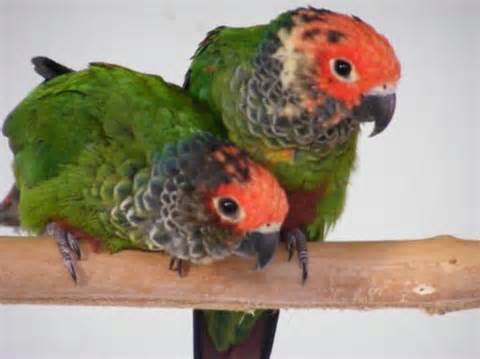The Painted Conure is a medium-sized species of conure parrot that belongs to the genus Aratinga in the family Psittacidae. It is known for its distinct plumage pattern, featuring bright hues of green, blue, yellow, and red. The species is native to South America, specifically the regions of Colombia, Ecuador, and Peru.
In terms of physical characteristics, the Painted Conure typically measures around 30cm in length and weighs between 120-135 grams. They have a relatively short tail, and their wings are relatively short and broad. They have a distinctive red patch on their forehead, which can be used to distinguish them from other Aratinga species. Their beak is strong and curved, adapted for cracking seeds and nuts.
In terms of behavior and ecology, Painted Conures are social and gregarious birds, often found in flocks of up to 50 individuals. They are active and playful, known to engage in aerial acrobatics and foraging behaviors. They have a wide vocal range and are known for their loud calls and screeches. They feed on a variety of seeds, fruits, and nuts, and have been observed using tools to obtain food.

In captivity, Painted Conures are popular as pets due to their bright plumage and playful personalities. They are known to be hardy and adaptable but require a significant amount of attention and mental stimulation to thrive. They have a lifespan of around 20-30 years with proper care. However, it is important to note that wild populations of Painted Conures are considered near threatened due to habitat loss and illegal trapping for the pet trade.
How to Stop Painted Conures Nipping
According to many owners of the lovely Painted Conure, the biggest complaint is their tendency to nip. Nippiness is an overwhelming tendency of this bird and if it isn’t stopped as soon as it begins, it can escalate into a real problem.
Of course, if you’re reading this article, then you likely already know that Painted Conures are nippy. They’re also potentially noisy – screeching to get your attention, to make you go away, and heck sometimes just to hear themselves talk.
So how do you get rid of your Painted Conure’s bad behaviors?
- Make sure they feel healthy, strong, and comfortable.
Is your Painted Conure getting enough sleep? He needs 10-12 hours of uninterrupted sleep in a dark room every day to feel his best. Is your Conure getting the proper nutrition? He needs an organic pellet-based diet supplemented with fresh fruits and veggies daily. Save the nuts and seeds for treat time – they make an awful diet and the result will be a very sick and grumpy bird – a bird that bites and yells.
Is your bird stimulated and comfortable? Is his cage big enough? Is he encouraged to forage and explore? Does he have fun and interesting toys to play with? Do you interact with him? Is his cage positioned in an area of your home where he feels safe, his back to a wall for example, and yet he is still able to interact with you and your family? This is important. A bird that feels threatened or bored is an unhappy bird, a bird that is inclined to nip and screech.
- Make sure your Painted Conure isn’t responding to your behaviors
Have you added a new pet or family member? Occasionally, jealousy of another bird, new family member, or new pet can cause your Painted Conure to misbehave. He may screech for your attention or bite when the offending person or animal enters the room.
If you react, you reinforce the behavior. Instead, try to learn what sets your Conure off. Read his body language and when he begins misbehaving you can be ready with an appropriate reaction, like turning your hand so he cannot bite it.
- Trick-train your Painted Conure.
In addition to being nippy and noisy, Conures can also be skittish birds. They don’t trust easily. Trick training is a wonderful way to build trust, to bond with your Painted Conure. Trick training will eliminate biting, screeching, and any other undesirable behavior.
